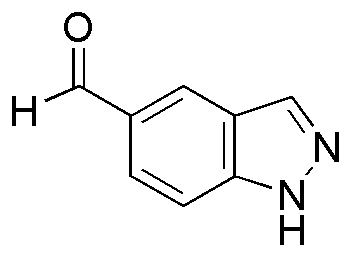1H-Indazole-5-carbaldehyde is widely utilized in research focused on:
- Synthetic Chemistry: This compound serves as a key intermediate in the synthesis of various indazole derivatives, which are important in developing pharmaceuticals and agrochemicals.
- Drug Development: Its unique structure makes it a valuable building block for creating potential therapeutic agents, particularly in oncology and neurology, where indazole derivatives have shown promising activity.
- Material Science: Used in the formulation of advanced materials, including organic light-emitting diodes (OLEDs), due to its electronic properties that enhance device performance.
- Biochemical Research: Acts as a useful reagent in biochemical assays, helping researchers study enzyme activities and molecular interactions, thereby facilitating drug discovery processes.
- Fluorescent Probes: The compound can be modified to create fluorescent probes for imaging applications in biological systems, aiding in the visualization of cellular processes.
General Information
Properties
Safety and Regulations
Applications
1H-Indazole-5-carbaldehyde is widely utilized in research focused on:
- Synthetic Chemistry: This compound serves as a key intermediate in the synthesis of various indazole derivatives, which are important in developing pharmaceuticals and agrochemicals.
- Drug Development: Its unique structure makes it a valuable building block for creating potential therapeutic agents, particularly in oncology and neurology, where indazole derivatives have shown promising activity.
- Material Science: Used in the formulation of advanced materials, including organic light-emitting diodes (OLEDs), due to its electronic properties that enhance device performance.
- Biochemical Research: Acts as a useful reagent in biochemical assays, helping researchers study enzyme activities and molecular interactions, thereby facilitating drug discovery processes.
- Fluorescent Probes: The compound can be modified to create fluorescent probes for imaging applications in biological systems, aiding in the visualization of cellular processes.
Documents
Safety Data Sheets (SDS)
The SDS provides comprehensive safety information on handling, storage, and disposal of the product.
Product Specification (PS)
The PS provides a comprehensive breakdown of the product’s properties, including chemical composition, physical state, purity, and storage requirements. It also details acceptable quality ranges and the product's intended applications.
Certificates of Analysis (COA)
Search for Certificates of Analysis (COA) by entering the products Lot Number. Lot and Batch Numbers can be found on a product’s label following the words ‘Lot’ or ‘Batch’.
*Catalog Number
*Lot Number
Certificates Of Origin (COO)
This COO confirms the country where the product was manufactured, and also details the materials and components used in it and whether it is derived from natural, synthetic, or other specific sources. This certificate may be required for customs, trade, and regulatory compliance.
*Catalog Number
*Lot Number
Safety Data Sheets (SDS)
The SDS provides comprehensive safety information on handling, storage, and disposal of the product.
DownloadProduct Specification (PS)
The PS provides a comprehensive breakdown of the product’s properties, including chemical composition, physical state, purity, and storage requirements. It also details acceptable quality ranges and the product's intended applications.
DownloadCertificates of Analysis (COA)
Search for Certificates of Analysis (COA) by entering the products Lot Number. Lot and Batch Numbers can be found on a product’s label following the words ‘Lot’ or ‘Batch’.
*Catalog Number
*Lot Number
Certificates Of Origin (COO)
This COO confirms the country where the product was manufactured, and also details the materials and components used in it and whether it is derived from natural, synthetic, or other specific sources. This certificate may be required for customs, trade, and regulatory compliance.


